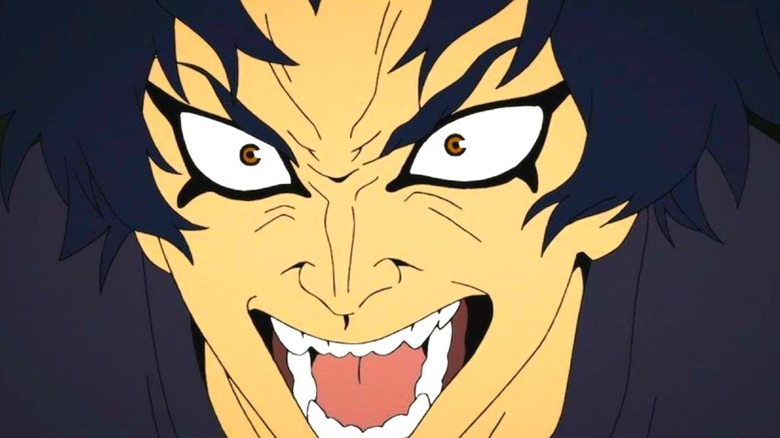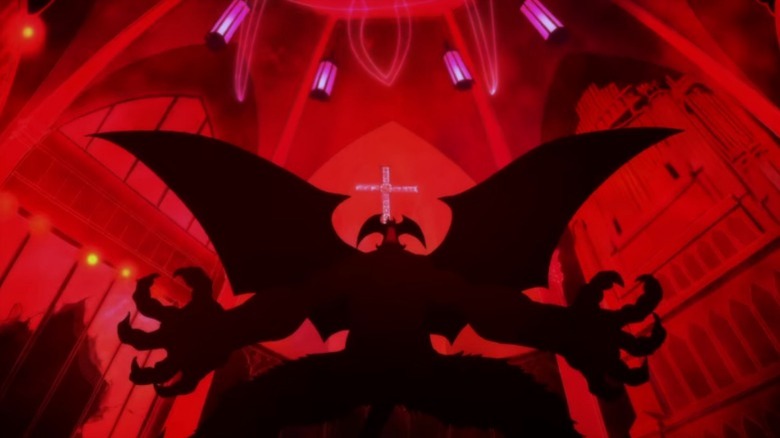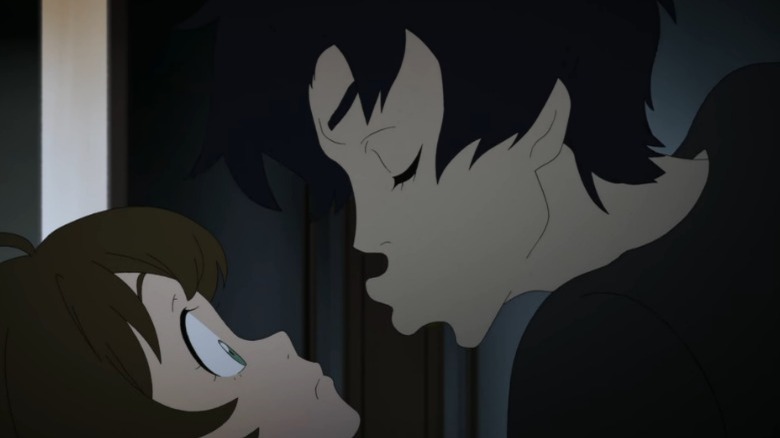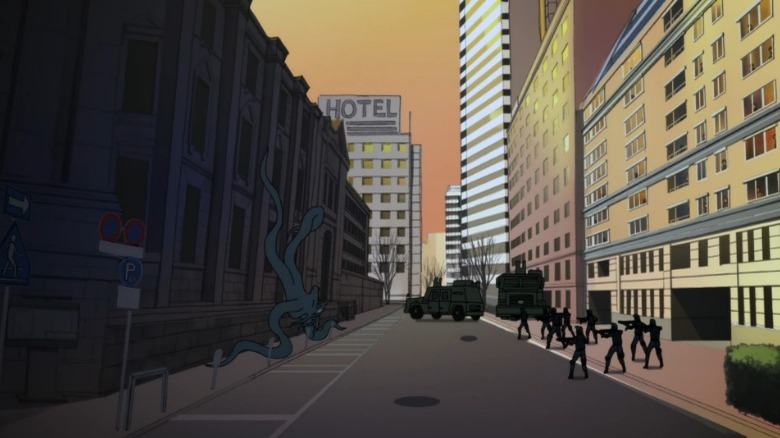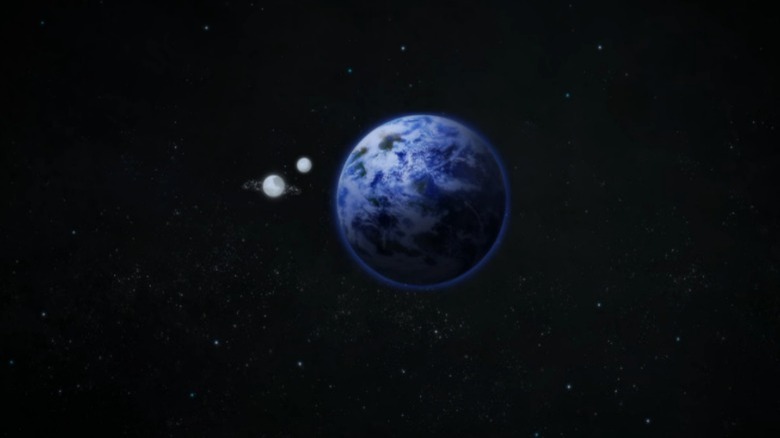The Ending Of Devilman Crybaby Explained
When it comes to anime and manga, few creators are more varied and prolific than Go Nagai. He's penned giant robot stories such as "Mazinger" and "Getter Robo," as well magical girl properties like "Cutie Honey," but Nagai's most famous — and cynical — is "Devilman." In many pieces of western media, if a human is possessed by a demon, the best case scenario is for the host to become a tortured-yet-salvageable shell like in "The Exorcist." At worst, they become zombies à la Doom that can only be "cured" with a shotgun to the brain. In "Devilman," humans usually become hulking abominations with prehensile hair scythes and acid-spewing breasts. However, if a person with a strong will is possessed, they can overpower the demonic influence and use their new body and power to kill the evil demons, essentially turning into a fusion of devil and man, hence the name.
"Devilman" first graced manga store shelves and television airwaves in 1972, and it has been reinvented multiple times for different audiences. While the manga source material was extremely dark and violent, the first anime adaptation was far more lighthearted and kid-friendly. The latest incarnation, Netflix's "Devilman Crybaby," is a sad, terrifying tale that is designed to tug at heartstrings and force audiences to ask if humans or demons are the true monsters. But, odds are you're too distracted by the body horror, so here's a quick and dirty explanation of the events, themes, and secrets of "Devilman Crybaby."
The devil is in the details — and the protagonists
"Devilman Crybaby" starts with a simple premise: Akira Fudo (Griffin Burns), an emotional crybaby, learns from his mature friend Ryo (Kyle McCarley) that demons are possessing humans. The best way to fight them is to let a demon into the body, overpower it through sheer force of will, and use the gained powers to mercilessly slaughter demons. Akira is possessed by the demon Amon and does regain his mental faculties, or enough to remember that he must kill demons, not humans.
At first, priorities lie in handling demons as they pop up, but as time goes on, Ryo's plan changes. Instead of keeping the anti-demon war a secret, Ryo develops an interest in revealing demons to the world, seemingly to alert the populace, as well as turn on Akira. However, due to a combination of base human instincts and (faulty) suggestions Ryo gives to help identify/kill demons, the world devolves into chaos as people starts to suspect everyone is a demon. Well, that's the kind of madness that makes demonic possessions sprout like mushrooms.
While Akira keeps his wits about him and tries to prevent unnecessary violence against innocent humans, Ryo loses his mind and starts to question his own motives. By the end of the series, everything makes sense: Ryo was Satan all along, and he wanted to destroy humanity. But, because he became friends with Akira, he wanted to make sure his best friend could survive the oncoming apocalypse, hence the demonic possession. The series ends with Ryo/Satan crying on Akira's bifurcated corpse as God nukes the planet.
Love conquers all
What sets good apart from evil in "Devilman Crybaby?" According to outlets such as Medium and YouTubers like Hiding in Public, the answer is emotion, especially love and sadness.
"Devilman Crybaby" immediately sets up Akira Fudo and Ryo as polar opposites. Akira is overly emotional and cries a lot, but he isn't weak. Akira loves everyone and wants them to be happy, but he's also a little too open to the emotions of others, so it's easy for him to cry, even when he's in his 20-ft demon form. That love for everyone is what helped him overpower Amon during his initial possession and keeps him going despite all the bloodshed.
Ryo, meanwhile, is devoid of emotion. Sure, he gets excited sometimes, but he can't really comprehend emotion, especially the feelings of others, because he has none. When Ryo starts to think he understands love, he hatches a plan to get rid of humanity and make sure that Akira survives and can return the feelings. Because Ryo ends up destroying the planet and killing Akira, you can see how well that turned out, but by doing so, Ryo feels genuine sadness and truly understands what it means to love, albeit too late.
Admittedly, Akira and Ryo are polar extremes within the show, and many other characters demonstrate love in its various forms. In fact, certain antagonists, such as Sirene and Kaim, blur the lines because although they are demons, they still convey emotions, even if Sirene is more into the erotic spectrum.
When is xenophobia called for?
During "Devilman Crybaby," Ryo announces to the world that demons and demon possession are as real and common as ham sandwiches. At this point, audiences don't know Ryo is literally the devil, so everyone viewing events from beyond the fourth wall wonders why he is appearing on news reports suddenly claiming that deviant behavior is a sign of demon possession. Well, not only is it part of an agenda locked within his subconscious, but according to analysts and YouTubers such as Wisecrack, it provides a strong message on the dangers of "moral panic" and "threat construction."
While demons are a very real threat in "Devilman Crybaby," much of what Ryo reveals to the public is duplicitous. Sure, demons can take over human bodies, but Ryo claims that acting differently is a sign of possession, which the show demonstrates is patently false. But, humans in the show fall for these claims and start hunting everyone who is different, engaging in literal witch hunts. By falling for these basic instincts, humans are arguably worse than the demons.
Moreover, as threats grow in "Devilman Crybaby," virtually every country suspects foreign leaders have been replaced by demons. Key players in this section include the U.S. and Russia, because Cold War rivalries die hard. Regardless of the veracity of these beliefs, the threat of staring down hostile nations controlled by demons is too much to bear, which results in nuclear warfare, quickening humanity's extinction.
If this theme sounds familiar, that's because Marvel tried something similar with the "Secret Invasion" storyline, but with aliens instead of demons.
Let's do the time warp again. And again. And again.
In the beginning (of "Devilman Crybaby"), God bombarded the Earth with angels and left it a molten husk. When the world cooled, the show's story picked up proper. In the end, God bombards the Earth once again. If you stick around after the end credits, you will see the Earth left a molten ball once again, cool, and then pop back into view with blue oceans and green continents, but with one extra moon. If you're wondering what happened, the answer is a time loop. Sort of.
In the original "Devilman" canon, Satan/Ryo is trapped in a time loop, repeating his existence and making the same mistakes. While many inter-loop similarities exist, each run is different, hence one time-looped Earth in "Devilman Crybaby" sports one moon and another sports two. In fact, judging by the first and last episodes, you can safely assume the first time demons invaded the Earth, they possessed dinosaurs, so God wiped them out. The resulting destruction reset the planet and created the moon, and when demons possessed humans again, God hit the nuclear reset button once more, which toasted the planet and birthed a second moon.
However, depending on how you look at things, each different incarnation of "Devilman" could be considered its own loop. At first glance, this rule might not apply to "Crybaby," because the first and last episodes imply the time loop isn't a reset of time, just the planet. However, because the show has its own in-universe "Devilman" TV program and merchandise (including a Devilman cat costume), perhaps "Crybaby" is yet another time loop and the in-universe Devilman media is humanity's way of remembering previous loops. It's up to viewer interpretation.
